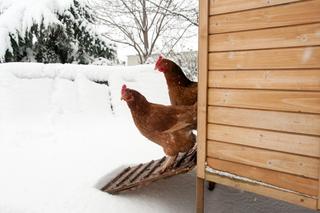How to Winterize Your Chicken Coop
Essential Tips for Cold Weather


While chickens do much better in the cold than one might expect, preparing your chicken coop is essential to keeping your flock warm, comfortable and healthy in the winter months. Your chickens will undoubtedly appreciate it and you want to avoid scrambling to make adjustments if the cold and snow arrives sooner than expected.
Without adequate preparation, your chickens could suffer from cold stress, decreased egg production and frostbite. This guide outlines the necessary steps to winterize your coop and prevent your flock from being too exposed to cold temperatures.
Depending on where you live, you may want to start this process in the fall. For example, if you live in the upper Midwest, you should winterize your coop around the middle of October.
Insulate and Ventilate
Like your home, your coop may need insulation to help retain heat, keep heating costs down and prevent drafts. In most U.S. regions, your coop structure should provide sufficient protection and insulation for your flock. Chickens can handle cold weather, but insulation can help maintain temperatures.
Stale air is a bigger concern for their respiratory health than cold weather. Ventilation is just as important, if not more important, than insulation. It is crucial for preventing moisture buildup and respiratory issues from droppings. When insulating a coop, make sure there is enough airflow.
Simple materials like foam boards and straw bales will work well to insulate your coop. Both are very accessible and cost effective.In addition to providing surprisingly great thermal insulation, foam boards are easy to cut and install, making them a convenient choice for DIY projects. However, you need to take special care to ensure that chickens cannot peck at and ingest any of the foam.
Straw is a natural insulator that traps air within its hollow stalks, creating an effective natural barrier against the cold. Straw can also be used as bedding inside for added insulation and comfort. Remember to keep bedding dry to prevent mold and mildew, which can pose health risks to your flock. Wood shavings, hemp, sand and chicken litter are other floor materials to consider.
Tarps, construction plastic, hardware cloths, blankets and polycarbonate boards can also be used as insulation materials around the run. Keep everything covered or out of reach to prevent chickens from pecking at it and eating it. Covering your chosen insulation materials with plywood paneling should do the trick.
You may fear that too much ventilation will allow this warm air to escape, but too much warmth can harm your chickens. Without proper ventilation, moisture gets trapped inside the coop and condenses on every available surface, making your birds susceptible to frostbite.
You should dedicate about a fourth of all wall space to ventilation. Position these areas where air can come in and out in places that won’t expose your flock to drafts.
When it comes to ventilation, too much is often better than not enough because you can always close it off or cover it up with insulation.
Keep Snow at Bay
Unsurprisingly, chickens aren’t the biggest fans of walking on snow. Using straw on the ground around your coop or placing makeshift roofs above commonly trafficked areas can help keep the snow out, allowing your chickens to roam when they choose in the colder months.
Setting up a wind block is another essential step to preventing snow from building up on and around a coop or run. In addition to preventing snow from blowing on the coop, wind blocks will reduce exposure to wind chill and prevent moisture from accumulating. Some of the same materials you used to insulate your coop, like straw bales, plastic paneling and tarps, can block the harsh winter winds.
Add Warmth by Electrifying Your Coop
Electrifying your coop with a radiant heater that can be mounted to an interior wall is a smart choice to provide additional warmth during extreme cold spells. Radiant heaters provide gentle, consistent warmth without overheating and are much safer than heating lamps and space heaters, as they reduce the risk of fire. If you go this route, I’d recommend running the heater for a few hours before installing it within your coop to remove the faint “new plastic” smell these products can sometimes have.
Winterizing a chicken coop doesn’t have to be complicated or expensive. Proper insulation, enough ventilation, wind blocks and a reliable heating option can ensure your chickens stay warm, dry and healthy throughout the winter.
Simple Steps to Winterize Your Chicken Coop
Use accessible materials like foam boards and straw bales to insulate your coop, while ensuring proper ventilation to prevent moisture buildup and respiratory issues.
Use straw on the ground and makeshift roofs to keep snow out of your chickens’ walking areas. Set up wind blocks using insulation materials to reduce wind chill and prevent moisture accumulation.
Consider installing a radiant heater for additional warmth during extreme cold spells. Radiant heaters are safer than traditional heating methods and provide consistent warmth.
Winterizing a chicken coop doesn’t have to be complicated or expensive. With proper insulation, ventilation, wind blocks and heating, you can keep your chickens warm, dry and healthy all winter long.
Depending on your location, begin winterizing your coop in the fall to ensure your chickens are ready for the cold months ahead.
Tags:Chicken Scratch

Chicken Whisperer is part of the Catalyst Communications Network publication family.














